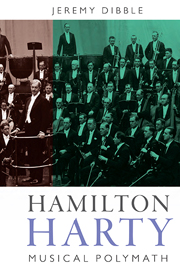Book contents
- Frontmatter
- Dedication
- Contents
- List of Illustrations
- List of Music Examples
- Preface
- Abbreviations
- Epigraph
- 1 1879–1901 Hillsborough, Belfast and Dublin: A Musical Apprenticeship
- 2 1901–9 London (1): A Pre-eminent ‘Collaborator’ and Aspiring Composer
- 3 1909–14 London (2): Composer and Conductor
- 4 1914–20 The War Years and After
- 5 1920–27 The Hallé Years
- 6 1927–33 Apogee: From Hallé to the LSO
- 7 1933–6 America and Australia: An Unforeseen Romance
- 8 1936–41 The Last Years: The Children of Lir – A Creative Codicil
- APPENDIX 1 List of Works
- APPENDIX 2 List of Recordings
- Bibliography
- Index of Harty's Works
- General Index
- Music in Britain, 1600–2000
1 - 1879–1901 Hillsborough, Belfast and Dublin: A Musical Apprenticeship
Published online by Cambridge University Press: 05 December 2013
- Frontmatter
- Dedication
- Contents
- List of Illustrations
- List of Music Examples
- Preface
- Abbreviations
- Epigraph
- 1 1879–1901 Hillsborough, Belfast and Dublin: A Musical Apprenticeship
- 2 1901–9 London (1): A Pre-eminent ‘Collaborator’ and Aspiring Composer
- 3 1909–14 London (2): Composer and Conductor
- 4 1914–20 The War Years and After
- 5 1920–27 The Hallé Years
- 6 1927–33 Apogee: From Hallé to the LSO
- 7 1933–6 America and Australia: An Unforeseen Romance
- 8 1936–41 The Last Years: The Children of Lir – A Creative Codicil
- APPENDIX 1 List of Works
- APPENDIX 2 List of Recordings
- Bibliography
- Index of Harty's Works
- General Index
- Music in Britain, 1600–2000
Summary
At the end of the nineteenth century the patronage of churches within the Anglican Communion was a common phenomenon. Many enjoyed the benefaction of wealthy Oxford and Cambridge colleges to pay the salaries of their incumbents and for the upkeep of church fabric – links that are still in many cases maintained today. Many village churches with a strong connection to adjacent landed families were generously supported; indeed, the provision of the church itself might well have come from the family coffers, the church obliging by acting as an appropriate burial place for their ancestors. One such edifice was the church of St Malachy, Hillsborough, in the Lisburn district of Co. Down. One of the finest examples of Gothic Revival architecture, it was built by the 1st Marquis of Downshire between 1760 and 1774 in anticipation, wrongly as it transpired, that it would be the diocesan cathedral of Co. Down. Though the Marquis, by the name of Wills Hill, may have been disappointed that his grand church was not honoured in the way he had hoped (the honour went to Down Cathedral, whose restoration the Marquis also helped to finance from 1790), his zeal for Hillsborough's reconstruction was in no way dampened. He went about modernising his house in the finest Georgian style, enthused by the sense of dynasty exhibited by his affluent forbears – beneficiaries of the Ulster Plantation who had developed and enlarged the estate over two centuries, and whose name, ‘Hillsborough’, had supplanted the original ‘Cromghlinn’ (as former land of the Irish Chieftain, Bryan McCrory Magennes).
- Type
- Chapter
- Information
- Hamilton HartyMusical Polymath, pp. 1 - 22Publisher: Boydell & BrewerPrint publication year: 2013



